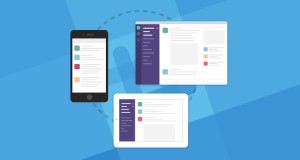Deliver Better Data-Informed UX Using Sisense Embedded Analytics

Key Takeaways
- Embedded analytics in apps can significantly enhance user experience and increase product ‘stickiness’ by providing useful, actionable data and interactive visualizations.
- Building in-house analytics capabilities can be resource-intensive and time-consuming, whereas third-party embedded analytics solutions like Sisense offer a cost-effective, faster alternative with high-quality source components.
- Key benefits of using Sisense Embedded Analytics include easy integration of low-latency dashboards into any application, streamlined integration designed by specialists, reduced time-to-market, and outsourced maintenance and support.
- Best practices for implementing embedded analytics include evaluating end users’ needs, optimizing data depth, and white-labeling the analytics experience to ensure seamless integration with the host application.
This article was created in partnership with StudioWorks. Thank you for supporting the partners who make SitePoint possible.
Businesses across just about every industry are learning to prioritize collecting data along the customer journey. And to an increasing degree, data reporting and interactive visualizations are a big component of the value that apps have to offer users, whether these users are within your organization, external stakeholders or mass market end users.
It doesn’t matter if your product is an executive dashboard that surfaces supply chain efficiency issues, a “quantifiable self” app that tracks biometrics for gamified fitness achievement or a business app that helps users keep track of project objectives – data storytelling is playing a bigger role in the interfaces of all digital products.
At the same time, app churn continues to haunt product teams, as the marketplace gets more and more saturated with apps that have overlapping use cases and functionalities – all the more reason to make quantifiable accomplishment a core component to your app’s interface. There’s arguably no better way to ensure app loyalty than to give users the sense that it’s a key component in their ongoing triumphs.
With this in mind, it’s easy to see why pretty much every mobile and web app today needs some sort of built-in analytics capabilities. Mobile app analytics can help you increase your product’s stickiness and deliver better user experiences. In turn, you’re able to create a high-value app for users that’s likely to be used more frequently.
So, the question isn’t whether or not you should add analytics capabilities to your app. It’s whether you should build your own or use a third-party solution?
The short answer is that it depends on a number of factors.
If you choose to build these analytics capabilities on your own, you’ll have more control over the app’s functionality and branding. In addition, you’ll be able to ensure that it functions exactly how you want it to, even if you need to set aside a budget for ongoing development and compatibility updates.
On the flip side, buying a third-party embedded analytics solution often makes for a far much less expensive option overall and you’ll be able to deploy the analytics capabilities in your app faster. Plus, you’ll get access to high-quality source components right off the bat, because you’ll be building on the experience of industry experts as opposed to an internal team that’s building out the capabilities from scratch on an as-needed basis.
In this article, we’ll dig deeper into the build versus buy dilemma of adding analytics capabilities to apps and explain why it’s better to use embedded analytics than build your own app components. We’ll also share some best practices for using Sisense’s embedded analytics solution in your apps.
Why Embedded Analytics Beats Building Your Own
One of the key benefits of using embedded analytics is that it offers easy access to data that’s useful. In other words, it allows you to integrate low-latency dashboards into any application. The dashboards are designed to present data in an easy to understand and actionable way which is more valuable for companies as it allows users to make informed decisions, faster.
According to MicroStrategy’s 2020 Global State of Enterprise Analytics Report, only 3% of employees can find the information they need quickly enough to make a data-driven business decision. With embedded analytics, you can improve the end user’s experience significantly and allow employees who aren’t adept at analytics to make data-driven decisions without reaching out to an IT expert.
In contrast, building these data visualizations and dashboards on your own requires a good amount of UI and UX work. Put simply, it’ll take a lot more effort, time, and resources to put together app components that are half as polished as what you would get with embedded analytics.
One of the major reasons why businesses choose to go with embedded analytics solutions is that embeddable platforms are designed by specialists and therefore offer streamlined integration that translates to the end user’s experience.
While you may certainly have the resources to put together an impromptu in-house analytics solution, making it usable is an entirely different ballgame. So, instead of spending time developing the analytics solution then refining the UI and UX, you can use an embedded analytics solution that’s ready out of the box.
As you can probably already tell, app analytics is pretty complex and therefore difficult to get right. To build out your own analytics app components, you’ll need a team of developers who are familiar with the requirements and data processing techniques as well as UI and UX experts who can translate that into easy-to-understand data visualizations.

The problem with going all-in with building your own analytics solution is that it leaves you with very little time and resources to focus on developing your core product offering. Using embedded analytics, then, reduces time-to-market.
As we mentioned earlier, developing your own app analytics solution gives you more control over functionality. However, this also means you’ll have to invest time and resources into keeping it updated and offering support. With embedded analytics, you can essentially outsource maintenance and ongoing support.
Tips for Building Products With Embedded Analytics
Embedded analytics makes it possible to implement fully developed business intelligence tools into apps. Here are some best practices to keep in mind to get the most value out of your embedded analytics.
1. Evaluate the End Users’ Needs
People in different industries will use analytics in a variety of different ways.
For example, ecommerce store owners might be more interested in marketing figures and sales data. On the other hand, businesses operating in the healthcare sector might instead seek to gauge the effectiveness of ER procedures or look for ways to reduce the high costs associated with avoidable ER visits.
Similarly, it’s also important to keep in mind that different users in the same industry or organization will also need to use analytics in different ways. Think of the different departments in just about every organization (such as business administrators and accounting departments) and how their analytics needs vary.
For this reason, it’s important to evaluate the end user’s needs and goals and take steps to make sure your embedded analytics solution matches them head-on.
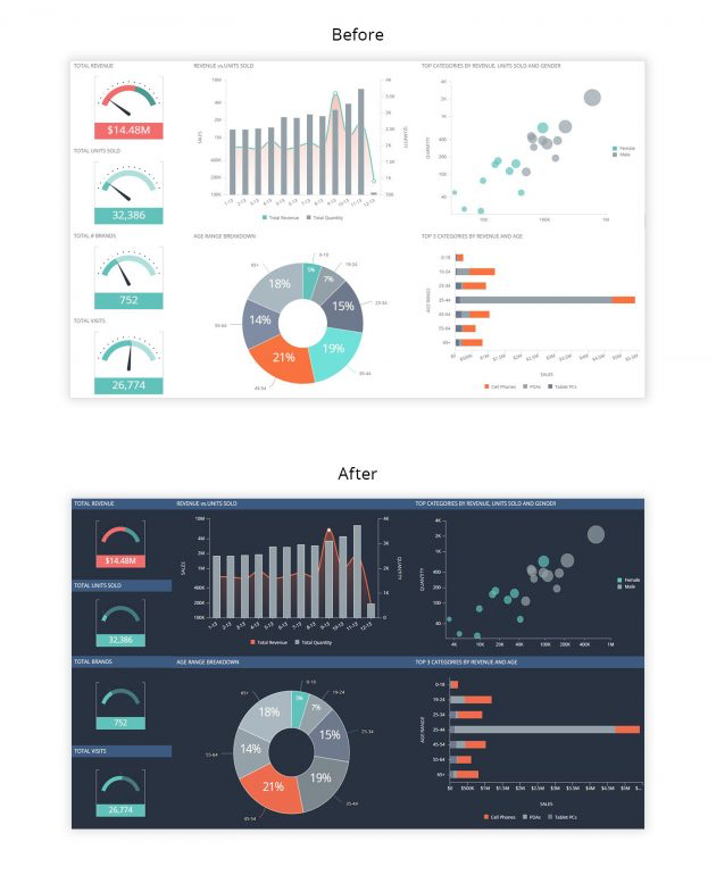
With Sisense, you can maintain consistent branding elements in your embedded analytics, ensuring that the user experience is seamless. In addition to this, you can customize color palettes and use visual hierarchies to your advantage so that the information and visualizations you present are consistent with all other aspects of the app you’re building.
2. Optimize the ‘Data Depth’
You don’t want to make your app’s analytics too complex for its target users. This not only delivers a poor experience but can potentially overwhelm the end-user. In design, sometimes less is more.
The first step is to map out the different analytics features you want to implement in the app. Next, check to see which types of users will need to access which analytics features and eliminate the ones you don’t need.
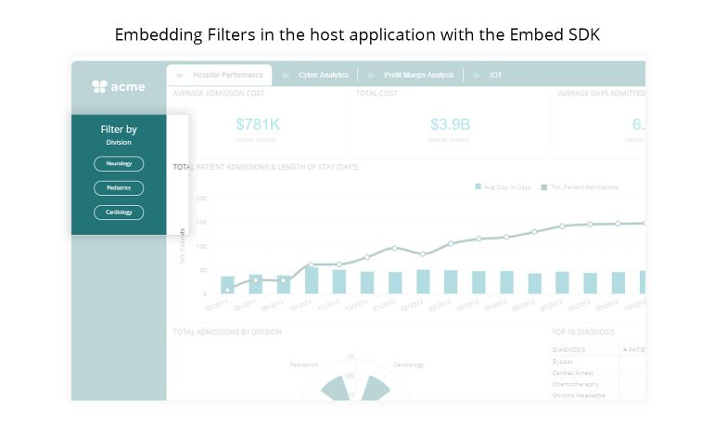
One way to strike the right balance and optimize the data depth your analytics solution delivers is to minimize the steps it takes users to access insights. For example, make sure to keep basic actions like exporting and filtering in one place.
That’s why it’s so important to go for an embedded analytics solution that’s easily customizable. This way, you’ll be able to tweak the underlying infrastructure with a simple drag-and-drop tool, plugin frameworks, SDKs and JavaScript APIs to refine the user experience.
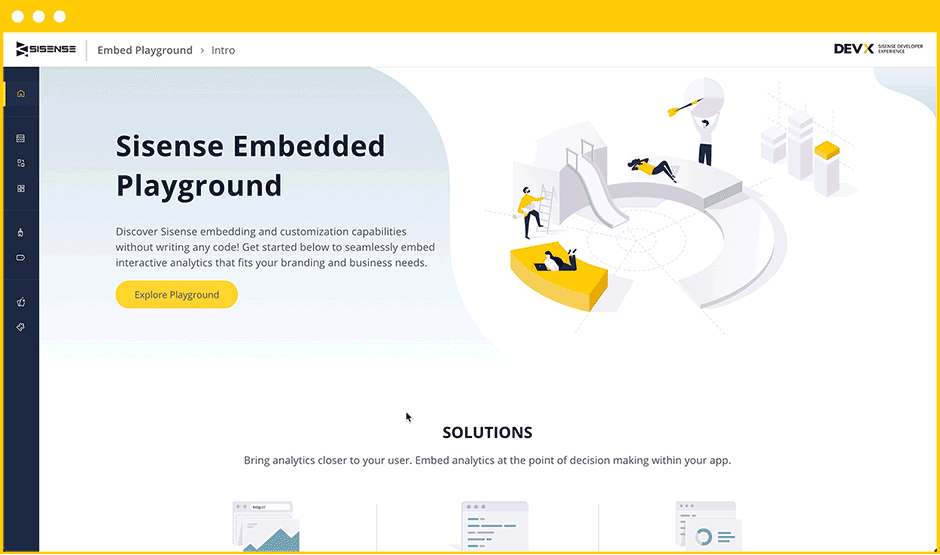
Sisense also offers an “embed playground” environment, where designers and developers can tinker with embeddable interfaces before deploying them for product implementation.
3. White-Label the Analytics Experience
Your analytics solutions should blend in with the host application seamlessly so you’re able to deliver a fully branded user experience. It should have the look and feel of a single application while giving you the flexibility to rebrand the UX.
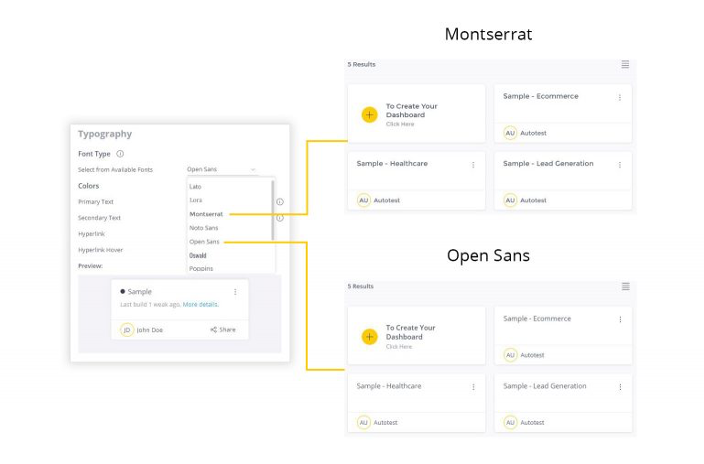
Sisense lets you build branding with typography and give your analytics app design some personality. You can use typography to enhance readability and improve navigation.
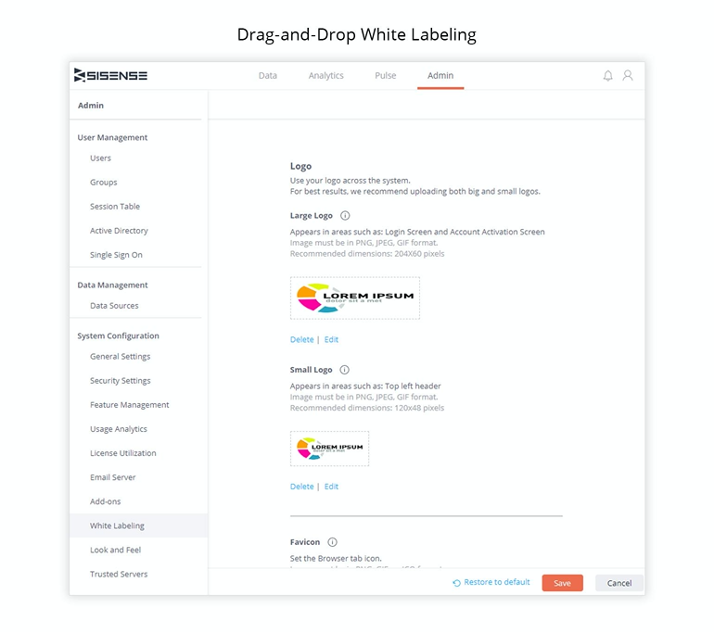
In addition to this, Sisense offers drag and drop white-labeling capabilities out of the box, which means you can remove traces of third-party apps and deliver a consistent brand experience without the need for custom development.
Conclusion
Offering in-app analytics is a great way to increase your app’s stickiness and provide more value to your users. Building an analytics suite in-house takes up a lot of resources, whereas embedded analytics solutions make it easier and faster to get their apps to market with minimal deployment.
By implementing some of the best practices we shared in this article, you can hone in on what your end-users need to get the most out of your embedded analytics solution and deliver better user experiences.
Frequently Asked Questions (FAQs) about Sisense Embedded Analytics
What is Sisense Embedded Analytics?
Sisense Embedded Analytics is a powerful tool that allows businesses to integrate data analytics directly into their applications, websites, or services. This tool provides real-time, interactive dashboards, reports, and visualizations that can be customized to fit the specific needs of the business. It enables users to make data-driven decisions without needing to switch between different platforms or applications.
How does Sisense Embedded Analytics improve user experience (UX)?
Sisense Embedded Analytics enhances UX by providing users with immediate access to relevant data within the platform they are already using. This eliminates the need for users to switch between different applications to gather and analyze data. The tool also offers customizable dashboards and visualizations, making data interpretation easier and more intuitive.
How can I integrate Sisense Embedded Analytics into my platform?
Sisense offers a variety of embedding methods to integrate its analytics into your platform. These methods include iFrame embedding, JavaScript API, and Reverse Proxy. The choice of method depends on your specific needs and technical capabilities. Sisense provides detailed documentation to guide you through the integration process.
What are the benefits of using Sisense Embedded Analytics?
Sisense Embedded Analytics offers several benefits. It allows businesses to provide their users with real-time, data-driven insights directly within their platform. This enhances user experience and increases user engagement. It also allows businesses to monetize their data by offering premium analytics features to their users.
Can I customize the look and feel of Sisense Embedded Analytics?
Yes, Sisense Embedded Analytics is highly customizable. You can tailor the look and feel of the analytics to match your platform’s branding. This includes customizing the colors, fonts, and layout of the dashboards and visualizations.
Is Sisense Embedded Analytics secure?
Sisense takes data security very seriously. The platform offers robust security features, including data encryption, user authentication, and access control. This ensures that your data is protected and only accessible to authorized users.
Can I use Sisense Embedded Analytics on mobile devices?
Yes, Sisense Embedded Analytics is designed to be responsive and works seamlessly on both desktop and mobile devices. This allows your users to access and interact with their data anytime, anywhere.
What types of data can I analyze with Sisense Embedded Analytics?
Sisense Embedded Analytics supports a wide range of data types. This includes structured and unstructured data, real-time data, and big data. The platform also supports data from various sources, including databases, cloud services, and APIs.
Do I need technical skills to use Sisense Embedded Analytics?
While having technical skills can be beneficial, Sisense is designed to be user-friendly and accessible to non-technical users. The platform offers a drag-and-drop interface, making it easy to create and customize dashboards and visualizations.
Can I share my Sisense Embedded Analytics dashboards and reports?
Yes, Sisense allows you to easily share your dashboards and reports with others. You can share them via email, embed them on your website, or even share them on social media. This makes it easy to collaborate and share insights with your team or clients.
Gal Shachar is a designer based in Tel Aviv who specializes in digital UX, ad media and branding. He has been active in the industry since 2017, following his studies at Ruppin College. Since then, Gal has been working with many well-known brands and businesses on web design, logo creation, user experience and branding campaigns. You can visit his website here.
Published in
·CMS & Frameworks·Development Environment·Meta·Miscellaneous·Patterns & Practices·PHP·October 1, 2014

